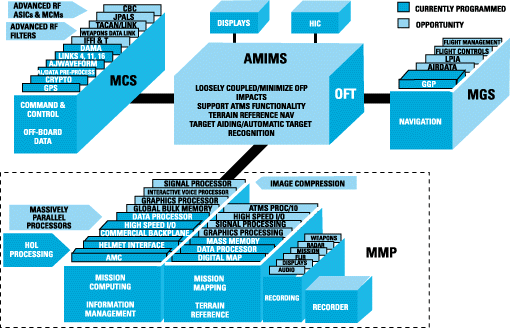AFFORDABLE AVIONICS
The current fiscal situation also demands that the service life of
existing weapon systems be extended and that - to the maximum extent possible
- we pursue
common solutions to common operational requirements. Consequently,
our avionics systems must be lighter, smaller, less complex, and possess
greater functionality. We must field dual-use systems that can adapt to
emerging communication, navigational, safety and computing concepts, and
that promote safe and efficient flight in Department of Defense, U.S. civil,
and European airspace.
We have responded to the austere funding environment by pioneering "win
win" partnerships between Naval Aviation and industry for updated, affordable,
and jointly-  interoperable
mission avionics. Ongoing acquisition reform efforts have provided the
opportunity to get the most out of our existing funding, enabling us to
achieve significant incremental decreases in unit cost and increases in
system reliability and readiness. Pre-planned digital technology insertion
for next-generation systems and the implementation of a commercial maintenance
concept virtually eliminates obsolescence issues. Acquisition savings and
the program manager's ability to leverage industry products and independent
R&D investments provides Naval Aviation with a rapid and cost-effective
means to achieve increased avionics functionality.
interoperable
mission avionics. Ongoing acquisition reform efforts have provided the
opportunity to get the most out of our existing funding, enabling us to
achieve significant incremental decreases in unit cost and increases in
system reliability and readiness. Pre-planned digital technology insertion
for next-generation systems and the implementation of a commercial maintenance
concept virtually eliminates obsolescence issues. Acquisition savings and
the program manager's ability to leverage industry products and independent
R&D investments provides Naval Aviation with a rapid and cost-effective
means to achieve increased avionics functionality.
Performance-based avionics requirements may allow us to share systems
with the Army, Air Force, Coast Guard, and commercial users. Future avionics
components used by Naval Aviation may also be used in other airborne, surface,
and ground-vehicle applications, a development that will benefit the entire
Department of Defense.
Our vision of air combat electronics in the next century includes a
systems approach that integrates modular hardware products - including
the Modular Communications System (MCS), the Modular Guidance/Navigation
System (MGS), and the Modular Mission Processor (MMP) - under the Advanced
Mission Information Management System (AMIMS). This "System of Systems
for Tomorrow" has significant growth potential. It will accommodate advances
in networking, broadcast intelligence, enhanced situational imagery, mission
replanning, targeting, and threat avoidance.
 System
Overview
System
Overview  Safety
Safety  Affordable
Avionics
Affordable
Avionics  C4/ISR
C4/ISR  Aircraft
Carriers
Aircraft
Carriers  Carrier
Air Wings
Carrier
Air Wings
 F-14
Tomcat
F-14
Tomcat  F/A-18
Hornet
F/A-18
Hornet  Joint
Strike Fighter
Joint
Strike Fighter  Airborne
Reconnaissance Vision
Airborne
Reconnaissance Vision  E-2C
Hawkeye
E-2C
Hawkeye  S-3B
Viking
S-3B
Viking
 ES-3A
Shadow
ES-3A
Shadow  Common
Support Aircraft
Common
Support Aircraft  EA-6B
Prowler
EA-6B
Prowler  Helicopter
Master Plan
Helicopter
Master Plan
 Marine
Corps Fixed-Wing Aircraft
Marine
Corps Fixed-Wing Aircraft  Marine
Corps Rotary-Wing Aircraft
Marine
Corps Rotary-Wing Aircraft  P-3C
Orion
P-3C
Orion  EP-3E
Aries II
EP-3E
Aries II  E-6A/B
Mercury
E-6A/B
Mercury
 Air-to-Air
Missiles
Air-to-Air
Missiles  Air-to-Ground
Weapons
Air-to-Ground
Weapons  Air-to-Subsurface
Weapons
Air-to-Subsurface
Weapons  Naval
Reserve Aviation
Naval
Reserve Aviation  Logistics
Airlift
Logistics
Airlift
 Training
Aircraft
Training
Aircraft  Aircrew
Training
Aircrew
Training  Aviation
Specialized Skills Training
Aviation
Specialized Skills Training  Logistics
Logistics  Expeditionary
Airfields
Expeditionary
Airfields
 Air
Traffic Control
Air
Traffic Control  Ranges
and Airfields
Ranges
and Airfields


 interoperable
mission avionics. Ongoing acquisition reform efforts have provided the
opportunity to get the most out of our existing funding, enabling us to
achieve significant incremental decreases in unit cost and increases in
system reliability and readiness. Pre-planned digital technology insertion
for next-generation systems and the implementation of a commercial maintenance
concept virtually eliminates obsolescence issues. Acquisition savings and
the program manager's ability to leverage industry products and independent
R&D investments provides Naval Aviation with a rapid and cost-effective
means to achieve increased avionics functionality.
interoperable
mission avionics. Ongoing acquisition reform efforts have provided the
opportunity to get the most out of our existing funding, enabling us to
achieve significant incremental decreases in unit cost and increases in
system reliability and readiness. Pre-planned digital technology insertion
for next-generation systems and the implementation of a commercial maintenance
concept virtually eliminates obsolescence issues. Acquisition savings and
the program manager's ability to leverage industry products and independent
R&D investments provides Naval Aviation with a rapid and cost-effective
means to achieve increased avionics functionality.